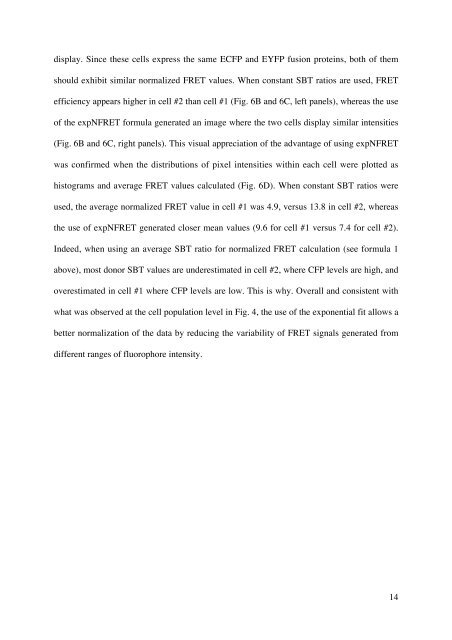PixFRET, an ImageJ plug-in for FRET calculation which can ...
PixFRET, an ImageJ plug-in for FRET calculation which can ...
PixFRET, an ImageJ plug-in for FRET calculation which can ...
- No tags were found...
Create successful ePaper yourself
Turn your PDF publications into a flip-book with our unique Google optimized e-Paper software.
display. S<strong>in</strong>ce these cells express the same ECFP <strong>an</strong>d EYFP fusion prote<strong>in</strong>s, both of themshould exhibit similar normalized <strong>FRET</strong> values. When const<strong>an</strong>t SBT ratios are used, <strong>FRET</strong>efficiency appears higher <strong>in</strong> cell #2 th<strong>an</strong> cell #1 (Fig. 6B <strong>an</strong>d 6C, left p<strong>an</strong>els), whereas the useof the expN<strong>FRET</strong> <strong>for</strong>mula generated <strong>an</strong> image where the two cells display similar <strong>in</strong>tensities(Fig. 6B <strong>an</strong>d 6C, right p<strong>an</strong>els). This visual appreciation of the adv<strong>an</strong>tage of us<strong>in</strong>g expN<strong>FRET</strong>was confirmed when the distributions of pixel <strong>in</strong>tensities with<strong>in</strong> each cell were plotted ashistograms <strong>an</strong>d average <strong>FRET</strong> values calculated (Fig. 6D). When const<strong>an</strong>t SBT ratios wereused, the average normalized <strong>FRET</strong> value <strong>in</strong> cell #1 was 4.9, versus 13.8 <strong>in</strong> cell #2, whereasthe use of expN<strong>FRET</strong> generated closer me<strong>an</strong> values (9.6 <strong>for</strong> cell #1 versus 7.4 <strong>for</strong> cell #2).Indeed, when us<strong>in</strong>g <strong>an</strong> average SBT ratio <strong>for</strong> normalized <strong>FRET</strong> <strong>calculation</strong> (see <strong>for</strong>mula 1above), most donor SBT values are underestimated <strong>in</strong> cell #2, where CFP levels are high, <strong>an</strong>doverestimated <strong>in</strong> cell #1 where CFP levels are low. This is why. Overall <strong>an</strong>d consistent withwhat was observed at the cell population level <strong>in</strong> Fig. 4, the use of the exponential fit allows abetter normalization of the data by reduc<strong>in</strong>g the variability of <strong>FRET</strong> signals generated fromdifferent r<strong>an</strong>ges of fluorophore <strong>in</strong>tensity.14
















